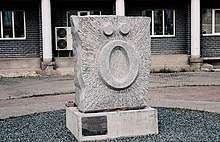O with diaeresis (Cyrillic)
O with diaeresis (Ӧ ӧ; italics: Ӧ ӧ) is a letter of the Cyrillic script. In all its forms it looks exactly like the Latin letter Ö (Ö ö Ö ö).
| Cyrillic letter O with diaeresis | ||||||||||||||||||||||||||||||||||||||||||||||||||||||||||||||||||||||||||||||||||||||||||||||||||||||||||||||||||||||||||||||||||||||||||||||||||||||||||||||||||
|---|---|---|---|---|---|---|---|---|---|---|---|---|---|---|---|---|---|---|---|---|---|---|---|---|---|---|---|---|---|---|---|---|---|---|---|---|---|---|---|---|---|---|---|---|---|---|---|---|---|---|---|---|---|---|---|---|---|---|---|---|---|---|---|---|---|---|---|---|---|---|---|---|---|---|---|---|---|---|---|---|---|---|---|---|---|---|---|---|---|---|---|---|---|---|---|---|---|---|---|---|---|---|---|---|---|---|---|---|---|---|---|---|---|---|---|---|---|---|---|---|---|---|---|---|---|---|---|---|---|---|---|---|---|---|---|---|---|---|---|---|---|---|---|---|---|---|---|---|---|---|---|---|---|---|---|---|---|---|---|---|---|---|
 | ||||||||||||||||||||||||||||||||||||||||||||||||||||||||||||||||||||||||||||||||||||||||||||||||||||||||||||||||||||||||||||||||||||||||||||||||||||||||||||||||||
| Phonetic usage: | [ø], [ə], [u], [œ], [ʌ] | |||||||||||||||||||||||||||||||||||||||||||||||||||||||||||||||||||||||||||||||||||||||||||||||||||||||||||||||||||||||||||||||||||||||||||||||||||||||||||||||||
| The Cyrillic script | ||||||||||||||||||||||||||||||||||||||||||||||||||||||||||||||||||||||||||||||||||||||||||||||||||||||||||||||||||||||||||||||||||||||||||||||||||||||||||||||||||
| Slavic letters | ||||||||||||||||||||||||||||||||||||||||||||||||||||||||||||||||||||||||||||||||||||||||||||||||||||||||||||||||||||||||||||||||||||||||||||||||||||||||||||||||||
| ||||||||||||||||||||||||||||||||||||||||||||||||||||||||||||||||||||||||||||||||||||||||||||||||||||||||||||||||||||||||||||||||||||||||||||||||||||||||||||||||||
| Non-Slavic letters | ||||||||||||||||||||||||||||||||||||||||||||||||||||||||||||||||||||||||||||||||||||||||||||||||||||||||||||||||||||||||||||||||||||||||||||||||||||||||||||||||||
| ||||||||||||||||||||||||||||||||||||||||||||||||||||||||||||||||||||||||||||||||||||||||||||||||||||||||||||||||||||||||||||||||||||||||||||||||||||||||||||||||||
| Archaic letters | ||||||||||||||||||||||||||||||||||||||||||||||||||||||||||||||||||||||||||||||||||||||||||||||||||||||||||||||||||||||||||||||||||||||||||||||||||||||||||||||||||
| ||||||||||||||||||||||||||||||||||||||||||||||||||||||||||||||||||||||||||||||||||||||||||||||||||||||||||||||||||||||||||||||||||||||||||||||||||||||||||||||||||
O with diaeresis is used in the alphabets of the Altay, Khakas, Komi, Kurdish, Mari, Shor and Udmurt languages.
Usage

In Altai, Khakas and Shor, it represents the close-mid front rounded vowel /ø/.
In Komi, it represents the schwa /ə/.
In Kurdish, it represents the close back rounded vowel /u/.
In Mari, it represents the open-mid front rounded vowel /œ/.
In Udmurt, it represents the open-mid back unrounded vowel /ʌ/.
In Russian books until the beginning of the 20th century, the letter Ӧ has been sporadically used instead of Ё in foreign names and loanwords (for example, the city of Cologne, Germany, which is Köln in German, might have been rendered in Russian as "Кӧльн").
In Tatar, this letter appeared in the 1861 Cyrillic orthography by Nikolay Ilminsky. This letter was replaced by Ө in 1939.[1]
Computing codes
| Preview | Ӧ | ӧ | ||
|---|---|---|---|---|
| Unicode name | CYRILLIC CAPITAL LETTER O WITH DIAERESIS | CYRILLIC SMALL LETTER O WITH DIAERESIS | ||
| Encodings | decimal | hex | decimal | hex |
| Unicode | 1254 | U+04E6 | 1255 | U+04E7 |
| UTF-8 | 211 166 | D3 A6 | 211 167 | D3 A7 |
| Numeric character reference | Ӧ | Ӧ | ӧ | ӧ |
See also
- О о : Cyrillic letter O
- Ö ö : O with diaeresis
- Cyrillic characters in Unicode
References
- "Tatar language", Wikipedia, 2019-12-03, retrieved 2019-12-03